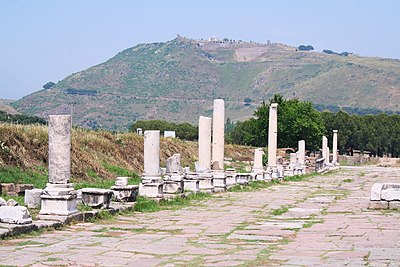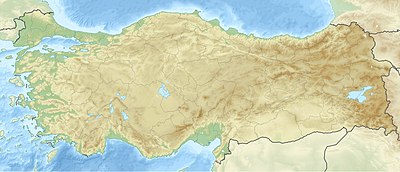Pergamon
Pergamon (Kleinasien) |


Pergamon (Greek: τὸ Πέργαμον "the Pérgamon", less commonly ἡ Πέργαμος "the Pérgamos"; Latin: Pergamum, less commonly Pergamus) was an ancient Greek city near the west coast of Asia Minor in present-day Turkey. It was situated on the northern edge of a plain formed by the river Caicus (today's Bakırçay). The built-up area rises at the feet, on the slopes and on the plateau of the acropolis, the core of which consists of a mesa-shaped massif of andesite rock about 335 metres high. Here stood the monumental Pergamon Altar erected under King Eumenes II in the first half of the 2nd century BC, the reconstruction of which with the original friezes can be seen today in the Pergamon Museum in Berlin. The castle hill slopes very steeply to the north, east and west, while the southern side forms a flatter transition to the plain via three natural steps. To the west, the Selinus (today Bergamaçay) flows through the city past the acropolis, while to the east flows the Ketios (today Kestelçay).
During the 3rd and 2nd centuries BC, Pergamon was the capital of the Kingdom of Pergamon, which extended over large parts of western Asia Minor. Under the art-loving Attalid dynasty, which strove to create a new Athens, the city became one of the most important cultural centres of Hellenism. The city was named after the parchment, which, according to an ancient legend, was invented there. The Turkish name of the city today is Bergama. Pergamon lies about 80 km north of Smyrna, today's İzmir.
In the Apocalypse of John, the third of the seven Epistles is addressed to the early Christian community of Pergamon, which the Christ dictates to the Evangelist John. According to Rudolf Steiner, Pergamon represents the Egyptian-Chaldean culture, the third cultural epoch of the post-Atlantean period.
„12 “And to the angel of the church in Pergamum write: ‘The words of him who has the sharp two-edged sword. 13 “I know where you dwell, where Satan’s throne is. Yet you hold fast my name, and you did not deny my faith[2] even in the days of Antipas my faithful witness, who was killed among you, where Satan dwells. 14 But I have a few things against you: you have some there who hold the teaching of Balaam, who taught Balak to put a stumbling block before the sons of Israel, so that they might eat food sacrificed to idols and practice sexual immorality. 15 So also you have some who hold the teaching of the Nicolaitans. 16 Therefore repent. If not, I will come to you soon and war against them with the sword of my mouth. 17 He who has an ear, let him hear what the Spirit says to the churches. To the one who conquers I will give some of the hidden manna, and I will give him a white stone, with a new name written on the stone that no one knows except the one who receives it.’“
Rudolf Steiner gives the following explanation:
„Now we go on, to the church at Pergamos. It is the representative of that epoch of humanity which stepped out more and more onto the physical plane, where man saw in the starry script what his spirit could fathom. This is given to man in the third cultural epoch. Man works through what is within him. Because he has an inner being, he can explore the outer. Only because he was endowed with a soul could he explore the orbit of the stars and invent geometry. This was called exploration by the Word, which is expressed in the Apocalypse of John by "the sword of the mouth". The one who has this letter written therefore indicates that the violence of this epoch is a sharp word, a sharp, double-edged sword. This is the Hermes-word of the old priests, the word by which the forces of nature and the stars were investigated in the old sense; this is that culture which is preferably won by the inner astral-soul forces of man here on the physical plane. If it is still gained in that old form, it is really a very double-edged sword. Wisdom stands on the edge between white and black magic, between that which leads to bliss and that which leads to ruin. That is why he says that he knows that where the representatives of this epoch dwell, there is also Satan's chair. This points to everything that can lead away from the real great goals of development. And the "teaching of Balaam" is no other than the teaching of the black magicians, for that is the teaching of the devourers of the people. The devourers of the people, the destroyers of the people are the black magicians who work only in the service of their own personality and destroy all community, therefore devour everything that lives in the people. But the good thing about this culture is that it is precisely there that man can begin to purify and transfigure his astral body. This is called the "hidden manna". That which is only for the world, transformed into food for God, that which is only for the egoistic man, transformed into the divine, that is called "hidden manna". All the symbols here indicate that man purifies his soul to make himself the pure bearer of Manas.“ (Lit.:GA 104, p. 80f)
Literature
- Rudolf Steiner: Die Apokalypse des Johannes, GA 104 (1985), ISBN 3-7274-1040-X English: rsarchive.org German: pdf pdf(2) html mobi epub archive.org
 |
References to the work of Rudolf Steiner follow Rudolf Steiner's Collected Works (CW or GA), Rudolf Steiner Verlag, Dornach/Switzerland, unless otherwise stated.
Email: verlag@steinerverlag.com URL: www.steinerverlag.com. Index to the Complete Works of Rudolf Steiner - Aelzina Books A complete list by Volume Number and a full list of known English translations you may also find at Rudolf Steiner's Collected Works Rudolf Steiner Archive - The largest online collection of Rudolf Steiner's books, lectures and articles in English. Rudolf Steiner Audio - Recorded and Read by Dale Brunsvold steinerbooks.org - Anthroposophic Press Inc. (USA) Rudolf Steiner Handbook - Christian Karl's proven standard work for orientation in Rudolf Steiner's Collected Works for free download as PDF. |


